- Animal health
- Animal Nutrition
- Genetic and Biodiversity
- Environment and natural resources protection
- Socio-economy in pig production sector
- Quality and food safety
- Animal husbandry and sustainable practices
- Rural Development
Integrating genetic improvement | into livestock development in low-input production systems
Long-term strategies for improvement schemes in tropical production systems should focus on the use of indigenous populations, in purebred or in crossbreeding systems with improved breeds...
Introduction
Medium- to low-input systems dominate ruminant livestock production in developing countries. In arid and semi-arid areas these are pastoral or livestock-crop (agropastoral) systems. Crop-livestock (mixed) systems dominate in the wetter and sub-humid areas (including the sub-tropical highlands). Associated with these and with landless and marginalized households are non-ruminant livestock - mainly backyard or scavenging pigs and poultry. According to Sere and Steinfeld (1996) medium- to low-input systems provide all - or at least the major part of - the livelihoods of the livestock-keeping households, many of whom have few resources beyond their smallholdings and livestock. For many it may be difficult to access markets to buy inputs and services or to sell their livestock products. Therefore an important “improvement” objective of livestock development is to improve the stability of production - and thereby reduce risk – in order to increase the food security and well-being of producer households (Livestock in Development, 1998).
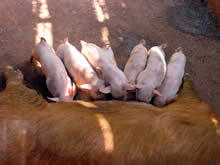
Long-term strategies for improvement schemes in these production systems should focus on the use of indigenous populations, in purebred or in crossbreeding systems with improved breeds. Genetic material and selection programmes should be carefully chosen according the characteristics of local systems and resource availability and on the basis of well-designed genotype evaluation trials.
Integration of genetic improvement activities with other programmes
For genetic improvement programmes to be sustainable, an integrated systems approach is required. Components should include production efficiency, economic viability, environmental compatibility and social responsibility (Moser, 2001). In medium- to low-input production systems in developing countries, animals may serve several functions including food securitynon-monetary functions such as insurance and social roles. Increasing livestock production may be constrained by climatic effects, feed shortage, disease risk and poor access to input and output markets. For livestock improvement programmes to be successful, these constraints must be recognized and addressed so that solutions can be integrated within a balanced holistic approach to improvement that responds both to the needs of producers and their markets. Governments should be made aware of the importance of genetic improvement and encouraged to create favorable conditions through economic incentives, the allocation of resources for applied research, training programmes, etc.

Farmer involvement and capacity building. As the example of dairy in India illustrates, effective improvement programmes generally require community-based collective action based upon groups of farmers having shared objectives and an effective organizational structure, including its legal status. Increases in productivity in the short-term through management interventions assure farmer motivation well before the first positive breeding effects may be visible. In the Transkei region of South Africa, genetic improvement of wool sheep is achieved through integrating it with an overall wool sheep improvement programme. Shearing sheds were established (Swart et al., 2000) which served as training, management, development and marketing centers. Members were trained in livestock management, health care, wool classing and other non-livestock programmes. As a result of the better classing of the wool, income from wool sales increased dramatically. Subsequently a structured wool sheep genetic improvement programme was established to increase the value of the wool.
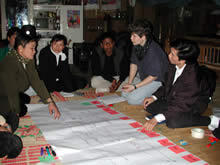
Genetic versus environmental development. In practice, breeding strategies generally evolve in response to changes in production systems, farmers’ preferences and production objectives, farmers’ knowledge about breed characteristics and market opportunities (Amer et al., 1998; Jabbar et al., 1999). A striking example is Kenya, which amongst developing countries, has one of the most rapidly expanding dairy sub-sectors. Presently, smallholders, living mainly in the highland areas, own about 80% of the estimated 3 million dairy cattle, comprising of mainly high grade Friesian and Ayrshire and their crosses with Bos indicus cattle (Small East Africa Zebu, Boran and Sahiwal - Omore et al., 1999). These responses to agricultural policies, human population pressure on land and market opportunities, have resulted in extensive breed substitution of the Small East Africa Zebu (SEAZ). This was accompanied by the keeping of smaller herds with fewer heifers but more cows, while stocking rates were increased through stall-feeding, fodder growing, purchasing of feeds, thus becoming more dependent on external inputs and services (Bebe et al., 2002). As a result, smallholders can sell more milk and capture the benefits for crop production from manure application. This example shows how improved production can be achieved through better management of production resources and the provision of input services interacting advantageously with breed substitution (SEAZ by European dairy breeds) when these changes are responding to markets that link large numbers of small-scale producers to the consumers of their livestock products. Within production systems where livestock may be communally managed or grazed on common properties, genetic improvement programs have various constraints, namely for example: low numbers per owner, difficulty to identify contemporary groups, free roaming males and early slaughter of males for cultural/financial purposes. In the absence of these constraints, the development of the Dorper sheep and Boer goats in South Africa illustrate what can be achieved. In systems with a limited resource potential for intensification (for example for ruminants and camelids and in semiarid to arid environments or in mountainous regions)the main challenge is link traditional breeding practices with scientific concepts, to be able to adapt to changing environmental and socio-economic conditions.
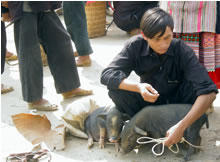
Management of genetic improvement programmes
For sustained genetic improvement to occur in an agricultural system, there must be market incentives driving and meeting the cost of both the improvement as well as the increased risks associated with change in genotype and its interactions with environmental factors like diseases or drought. In the same way, increased performance in one trait or function, e.g. leaner meat, may be offset by lowered performance in other traits, e.g. reproductive rate or reduced suitability for traction. Understanding these multiple and often interacting production functions and taking them into consideration when defining improvement goals with farmers are prerequisites for effective livestock development. For example, many medium- and low-input systems in developing countries are crop x ruminant livestock (mixed) systems with cattle or buffalo. Milk is produced to feed the family and for sale, to produce manure for the support of crop production and to have animals for insurance and financing emergency cash needs and for social status (Udo and Cornelissen, 1998). In some countries, e.g. in Bangladesh, female cattle may also serve as traction animals.

Through case studies, various improvement programmes have been described, mainly consisting of government or project funded open nucleus breeding systems (ONBS). Establishment of an ONBS may be useful in places where the development of the infrastructure for artificial insemination, recording of production and genetic evaluation may not be feasible in the general population or at least where the incorporation of a significant proportion of the local population in a breeding programme is not practicable. However, the operation of an ONBS programme is very challenging, and only sustainable with adequate financial support and technical backup and the active participation of a group of pilot farmers. And, as yet, there are no documented schemes in developing countries demonstrating their successful implementation.
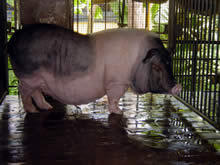
The use of exotic breeds in a crossbreeding program for sheep and goats is often difficult to manage in low-input production systems. Crossbreeding of local breeds with Finnsheep in Egypt (Aboul-Naga, 2000) achieved higher fertility with lower growth rates, carcass traits and survival rates. ¼ Finns outperformed local breeds with faster growth rates and better carcasses but this crossbreeding programme was difficult to sustain at the farmer level. In tropical Latin- American countries, the use of Holstein and other high-producing dairy breeds from temperate climates is very popular for crossbreeding with local Zebu type females for producing F1 animals for dual purpose systems (milk and meat production). Research shows however, that ¾ European have economical results very similar to the F1 in most environments (Rege, 1998), suggesting perhaps that a strategy for creating a tropical synthetic breed such as the Siboney in Cuba, could be a reasonable medium to long term strategy.
Relevance of advanced technologies
Reproductive technology. Technologies with potential for impact on genetic improvement programs are available or are currently being developed. Artificial insemination (AI) and multiple ovulation and embryo transfer (MOET), associated or not to in vitro fertilization (IVF), are available as routine techniques and able to contribute to increased selection efficiency of local programs, but, with the exception of AI, have as yet contributed little to improving the majority of low- and medium-input systems. Sexed semen may offer some advantages, particularly for meat producing systems (Benyshek, 1998; Bulfield, 1998; Montaldo, 2002) and for smallholder dairy systems, especially where the opportunities for systems stratification are limited.
Across-breed evaluations. Methodologies such as extensions of the mixed model methods for animal evaluation to include multi-breed or multi-population situations have great potential to serve as a basis for a more efficient selection of mixtures of local and exotic populations found in many systems in developing countries. This could be an efficient strategy to preserve valuable alleles for local conditions, provided rational selection criteria are used (Notter, 1999; Montaldo, 2001). These applications will be dependent upon the availability of performance records, an essential criterion infrequently met in these systems.
Use of molecular genetics in animal breeding. The biotechnologies that currently seem to be particularly useful for medium- to low-input systems are for parentage and animal identification with molecular markers in situations where genealogical recording and animal identification is difficult. The development of AI services and in some cases, particularly in the context of ONBS, the integrated use of MOET and marker assisted selection (MAS) technology seems promising, subject to adequate market incentives and the capacities of local institutions.
Information technology. Successful genetic improvement action requires many decisions, generally by a range of stakeholders, particularly farmers, across time and space. In turn, sound decisions depend upon those involved having ready access to relevant and timely information. In this respect the oncoming information age offers a number of important opportunities for increasing both the efficiency and effectiveness of decision support to breeding programs. These opportunities will only increase, with the issues critical to their use being: what information is required, by whom, when, and in what form is it best provided. Information on the benefits from improved management practices can serve as an important stimulus to generate and sustain farmer involvement in genetic improvement programmes. The application of technical solutions for the identification of individual animals (including implantations allowing the use of remote sensing tools) may facilitate breeding work in conditions up to now excluding application of methods of population genetics, provided the returns to producers outweigh the costs. Also pedigree identification through molecular genetic methods opens up new possibilities of breeding under extensive production conditions. Information systems and application of all kinds of communication tools (from those for illiterates from Rapid Rural Appraisal methods up to internet connected computers) can improve internal flow of information including market statistics for example, breeders associations. Access to computing technology and the internet, as well as reduced costs, open many interesting options for breeding organizations to analyse data with suitable mixed model methodologies and to interchange data in a timely way.
Conclusion
In low- to medium-input smallholder production systems the integration of genetic improvement programmes with other livestock improvement activities including the management of environment and animal health, product preparation for market and practical training, is essential. Field experiences have shown that for these programmes to be successful, there must be a very clear definition (through applying participatory approaches) and understanding of producers’ multiple objectives and their contribution to breeding goals. Public and private good returns from genetic improvement for resource-poor producers and their incorporation in the design of schemes to maximize the synergy of public and private investments (e.g., in AI for dairy) is a prerequisite. Governments must play a active role in stimulating long term genetic improvement programmes through infrastructure to support animal recording, training, accessibility of input and output markets, etc.
Participation of farmers and their self-organisation within marketing or breeder associations (which may be co-operatives) that focus on their needs, are two important factors required for the success of any genetic improvement programme. Breeding costs must be taken into consideration, given that generally government or NGO support will be limited in amount and duration. To be viable, integrated breeding programmes must generate immediate user benefits, while linking the benefits to obligations and balancing the returns to the costs of the services provided. The investments in genetic improvement must be assessed for its costs and benefits over years, clearly identifying who bears the costs and who benefits. Building supportive institutions and the capacities of producers and the technicians who serve them, are two important policy issues that need to be addressed when designing effective breed improvement programs in medium- to low-input production systems. Organisational and legal support for breeders’ associations will be required, including ensuring that they are able to retain their rights to indigenous genetic resources. The ability (either directly or through government support) to meet the costs of knowledgeable technicians is essential, as is assuring access to secure markets for surplus/improved quality production. To sustain the programme, the organisation of reliable and timely information for collective action groups such as breeders’ associations and to external sources (from product prices to the contents of international conventions) will be pivotal. Underpinning that information flow will be simple animal recording and evaluation schemes, designed to create functional improvement programmes, serving as the basis for a virtuous circle extending to more farmers and facilitating. In turn they will facilitate the incorporation of more elaborate technologies such as artificial insemination, and where financial returns merit and institutional capacities allow, other technologies such as multiple ovulation, embryo transfer and marker assisted selection.
References
- Aboul-Naga, A.M. (2000) ICAR Technical Series No 3 : 293-299.
- Amer, P.R., Mpofu, N.and Bondoc, O. (1998) Proc. 6th WCGALP 28 : 97-103.
- Bebe, B.O., Udo, H.M.J., Rowlands, G.J. and Thorpe, W. (2002) Submitted to Livest. Prod. Sci.
- Benyshek, L.L. (1998) Proc. 6th WCGALP 23 : 43-49.
- Bichard, M. (2000) ICAR Technical Series No 3 : 5-12.
- Bulfield, G. (1998) Proc. 6th WCGALP 23 : 19-23.
- Jabbar, A.M., Swallow, B.M. and Rege, J.E.O. (1999) Outlook on Agriculture 28 : 239-243.
- Kurup, M.P.G. (2002) « Proceedings of the South-South Workshop on Smallholder Dairy Production and Marketing - Constraints and Opportunities » March 12th - 16th 2001, Anand, India. Livestock in Development. (1998) « Sustainable rural livelihoods : What contribution can we make ? » London: Department for International Development.
- Moser, B.D. (2001) Livest. Prod. Sci. 72 : 3-7.
- Montaldo, H.H. (2001) Interciencia 26(6) : 1-8.
- Montaldo,H.H.(2002) « Biotechnology » Eolss Publishers Co. Ltd., Oxford, UK
- Muriuki, H.G. and Thorpe, W. (2002) « Proceedings of the South-South Workshop on Smallholder Dairy Production and Marketing - Constraints and Opportunities ». March 12th - 16th 2001, Anand, India
- Nimbkar, C. (2000) ICAR Technical Series No 3 : 435-443.
- Notter, D.R. (1999) J. Anim. Sci. 77 : 61-69.
- Omore, A., Muriuki, H., Kenyanjui, M., Owango, M. and Staal, S. (1999) Report by the MoAKARI- ILRI Smallholder Dairy Project, ILRI, Nairobi, 50 pp.
- Rege, J.E.O. (1998) Proc. 6th WCGALP 23 : 193-199.
- Sere, C. and Steinfeld, H. (1996) FAO Animal Production and Health Paper 127. Rome: Food and Agriculture Organisation of the United Nations.
- Swart, D., Hobson, F.O. and Carstens, J.P. (2000) Proc. 3’rd All Africa Conference in Agriculture, Egypt .
- Udo, H. and Cornelissen, T. (1998) Outlook on Agriculture 27 : 237-242.
- Valle Zarate, A. (1996) Anim. Res. Develop. 43/44 : 99-118
- Valle Zarate, A. (2000) in Tulachan et al, ICIMOD Research and Dev. Issues
Comments
CIRAD © 2007 (All rights reserved) - Disclaimer stating - Page updated : 26/04/2007
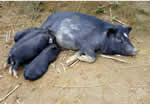
Pigs